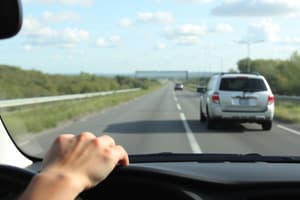Podcast
Questions and Answers
What must be done before starting a vehicle?
What must be done before starting a vehicle?
- Engage the handbrake
- Put in the key
- Disengage the handbrake (correct)
- Turn on the ignition
What is a common difference between UK and American cars regarding gear changes?
What is a common difference between UK and American cars regarding gear changes?
- UK cars are usually automatic
- American cars have more pedals
- American cars use a clutch
- UK vehicles are often manual (correct)
Which phrase is commonly used in American English when referring to the accelerator?
Which phrase is commonly used in American English when referring to the accelerator?
- Step on the brake
- Step on the gas (correct)
- Hit the clutch
- Step on the accelerator
What does 'bumper to bumper' refer to during a drive?
What does 'bumper to bumper' refer to during a drive?
Which of the following describes a backseat driver?
Which of the following describes a backseat driver?
What must be done after a drive is completed?
What must be done after a drive is completed?
What is the purpose of indicators when driving?
What is the purpose of indicators when driving?
What do 'turn up' and 'turn down' refer to when driving?
What do 'turn up' and 'turn down' refer to when driving?
What is an essential action to take before the car can start moving?
What is an essential action to take before the car can start moving?
What is the main benefit of enjoying music while driving?
What is the main benefit of enjoying music while driving?
Flashcards are hidden until you start studying
Study Notes
Car Vocabulary and Driving Essentials
- Start a drive by obtaining keys and unlocking the car.
- Important to wear a seatbelt; parents often enforce this rule: “We're not going anywhere until you put on your seatbelt.”
- Always disengage the handbrake before starting the vehicle.
Driving Differences: UK vs. America
- UK vehicles are often manual with gear changes; American cars are typically automatic.
- Automatic cars have two pedals: brake and gas (known as “hit the gas”); manual cars have three pedals: clutch, brake, and accelerator.
- In the UK, "step on the accelerator" is common, while American English favors "step on the gas."
Dashboard Controls and Functions
- Use phrasal verbs: “turn on” for activating devices (e.g., radio, AC, heating).
- Adjust volume with “turn up/down” for radios or temperature controls.
- Windows can be opened by “putting them down” or an older term “winding down.”
Indicators and Speed Management
- UK drivers frequently use indicators; American drivers may not, which can be frustrating.
- Indicators are referred to as "blinkers" or "turn signals" in the U.S.
- Speed is measured in miles per hour; phrases include "We're doing 70 miles an hour" or "Come on, speed up."
Navigation and Traffic Management
- Common navigation phrases: “Turn left here,” “Take your second right,” “Go straight ahead at the roundabout.”
- Rush hour can lead to heavy traffic; expressions include "it's bumper to bumper" or "we're not moving at all."
Enjoying the Drive
- Driving can be pleasurable with music and a comfortable environment; it's ideal for fresh air when windows are open.
- Post-drive actions include removing the seatbelt, engaging the handbrake, turning off the car, and locking doors.
Additional Driving Terminology
- “Set off” refers to starting a journey.
- Long journeys necessitate rest: “It's a long drive, let's get a good night's sleep.”
- A “back seat driver” is someone who gives unsolicited driving advice.
Car Vocabulary and Driving Essentials
- Begin driving by securing keys and unlocking the vehicle, emphasizing safety by always wearing a seatbelt.
- Parents often stress seatbelt usage with the phrase, “We're not going anywhere until you put on your seatbelt.”
- Disengage the handbrake prior to starting the engine to ensure the vehicle can move.
Driving Differences: UK vs. America
- UK cars predominantly feature manual transmissions requiring gear changes; American vehicles usually have automatic transmissions.
- Automatic vehicles are equipped with two pedals (brake and gas), while manual ones include three (clutch, brake, accelerator).
- In the UK, drivers commonly say "step on the accelerator," contrasting with the American phrase "step on the gas."
Dashboard Controls and Functions
- Activate dashboard features using phrasal verbs like “turn on” for devices such as the radio and air conditioning.
- Adjust sound levels on radios or air temperature using "turn up/down."
- Windows can be opened by "putting them down" or an older expression, "winding down."
Indicators and Speed Management
- UK drivers routinely utilize indicators, while American drivers may neglect them, causing frustration for others.
- In the U.S., indicators are known as "blinkers" or "turn signals."
- Speed is measured in miles per hour; common phrases include "We're doing 70 miles an hour" and "Come on, speed up."
Navigation and Traffic Management
- Common driving directions include "Turn left here," "Take your second right," and "Go straight ahead at the roundabout."
- Rush hour can create significant traffic congestion, described with phrases like "it's bumper to bumper" and "we're not moving at all."
Enjoying the Drive
- Driving can be enjoyable with music and a pleasant atmosphere, especially when the windows are open for fresh air.
- After driving, actions include removing the seatbelt, engaging the handbrake, turning off the engine, and locking the doors.
Additional Driving Terminology
- The phrase “set off” signifies the beginning of a journey.
- Long drives require breaks, as indicated by “It's a long drive, let's get a good night's sleep.”
- A "back seat driver" refers to a person who offers unsolicited driving advice.
Studying That Suits You
Use AI to generate personalized quizzes and flashcards to suit your learning preferences.


